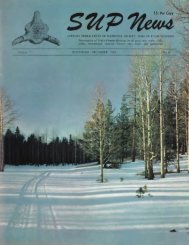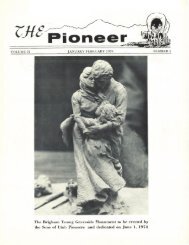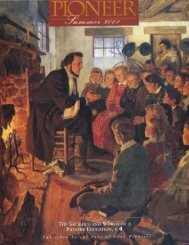Create successful ePaper yourself
Turn your PDF publications into a flip-book with our unique Google optimized e-Paper software.
enormous. Southern sympathizers in Congress protected<br />
John Butterfield’s interests, and the big and eagerly anticipated<br />
mail contract never materialized. These factors,<br />
coupled with losses incurred by the umbrella company,<br />
Russell, Majors and Waddell, during the Utah War, drove<br />
that firm into bankruptcy. By summer of 1861, the company<br />
had broken up, with the mail service in other hands,<br />
but the ponies ran as long as the need existed.<br />
Overlooking the financial aspect, the Pony accomplished<br />
all that its backers had hoped, and more. The argument<br />
by many in the East and the South that the direct<br />
route across the American continent, the Central Route,<br />
was not practical for year round travel was put to rest.<br />
The Civil War was a period of greatest national turmoil.<br />
The Pony Express provided a vital link between<br />
California and the rest of the States in the months leading<br />
up to the war and through the early months of the<br />
conflict. Some historians have credited the Pony Expess<br />
with helping to preserve California’s loyalty to the<br />
Union. Surely all citizens of the West awaited with baited<br />
breath the latest news of events which would determine<br />
the future of the nation.<br />
These accomplishments could be looked on with<br />
pride by the men who made the Pony Express happen.<br />
Could they have imagined that, 150 years later, its legend<br />
would have grown to the present proportions? Children<br />
in grade school hear the story of the Pony Express. People<br />
around the world love the image of<br />
the young man on his fast horse,<br />
speeding his precious cargo in<br />
spite of all obstacles. In <strong>2010</strong>, we<br />
celebrate<br />
the sesquicentennial anniversary of what seems to us one<br />
of the most thrilling and romantic episodes in the opening<br />
of the American West. “Return with us now to those<br />
thrilling days of yesteryear. . . .”<br />
Utah and her people played a key role in the success<br />
of the Pony Express. Salt Lake City was the largest<br />
population center in almost 2000 miles of wilderness and<br />
was important in every aspect of the Pony Express operation.<br />
Utah Pony riders were prominent among the mail<br />
carriers across the Intermountain West. Thomas Owen<br />
King’s portrait hangs in the Daughters of Utah <strong>Pioneer</strong>s<br />
Museum in Salt Lake City. Elijah Nicholas Wilson has a<br />
town in Wyoming named for him, and Jack Keetley has<br />
one in Utah. Keetley and the Gilson brothers, Sam and<br />
James, made their fortunes in mining after their Pony<br />
Express days. Brothers John and William Frederick<br />
Fisher became leaders in the LDS Church. James<br />
Bromley, whose home was at Echo, was division superintendent<br />
for a section of the line east of Salt Lake City.<br />
Major Howard Egan was the man in charge from Salt<br />
Lake City west to Roberts Creek, now central Nevada.<br />
Bolivar Roberts had responsibility on the western end.<br />
Although Roberts lived in California, he also had strong<br />
Utah ties. Many other examples could be listed.<br />
The trail crossed Utah Territory all the way from<br />
western Wyoming to the Sierras. It followed the Mormon<br />
<strong>Pioneer</strong> Trail, entering present-day Utah at the Needles<br />
on Yellow Creek. Down Echo Canyon, stops included<br />
Castle Rock and Halfway near the railroad siding at<br />
Emory. A fair little town existed at Echo, where the<br />
Express station was run by James Bromley, one of the division<br />
superintendents on the line. After crossing<br />
Hogback Summit, the rider made stops at Dixie Hollow<br />
and at Bauchmann’s Station on East Canyon Creek, a location<br />
now on the Clayton–McFarlane Ranch. On the<br />
south side of Big Mountain, now near the head of Little<br />
Dell Reservoir, Ephraim Hanks had an establishment for<br />
travelers which served the Pony Express also. Crossing<br />
Little Mountains and entering the Salt Lake Valley via<br />
Emigration Canyon, the rider got a well-earned rest at<br />
the Salt Lake House, a hotel and home station at 143<br />
South Main. From downtown Salt Lake City, the mail<br />
traveled south along the route of State Street to the area<br />
of the Utah State Prison. Porter Rockwell’s Hot Springs<br />
<strong>2010</strong> ◆ Vol. 57, <strong>No.2</strong> ◆ PIONEER 9







